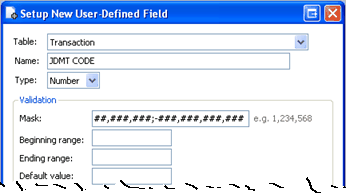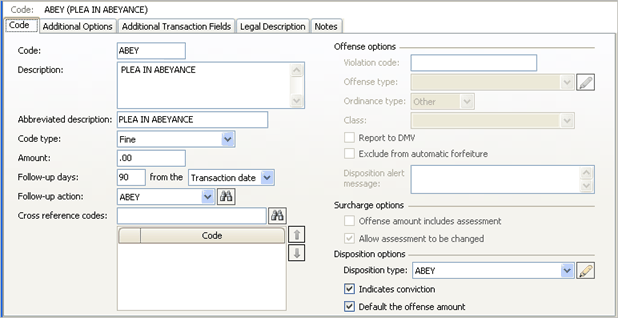How do I set up a Plea in Abeyance disposition?
A plea in abeyance is an agreement that allows the court to dismiss a violation based on the defendant's ability to complete a set of requirements as outlined in the agreement. This section tells you how to set up a code for plea in abeyance, enter an additional amount, and enter dispositions.
Add a code for plea in abeyance
Before you can enter a disposition for a plea in abeyance, you will need to
Add a disposition type for plea in abeyance
Add an action code for plea in abeyance
Add fields to collect the BCI Disposition code and JDMT code
Step 1: Add a disposition type for plea in abeyance
Use Disposition Types to create a disposition type to record a plea in abeyance.
Do this...
1. Open Connect Court Management > Organization > Disposition Types.
2. Click New (CTRL+N).
3. Enter ABEY in the Description field.
4. Enter ABEY in the Abbreviated Description.
5. Click Save (CTRL+S).
The disposition type is saved.
Step 2: Add an action code for plea in abeyance
Create an action code to attach the plea in abeyance letters and forms.
Do this...
1. Open Connect Court Management > Organization > Action Codes.
2. Click New (CTRL+N).
3. Enter ABEY in the Action Code field.
4. Set up the options on the ABEY action code with the letters and forms that will print as a follow up the plea in abeyance.
If additional instructions are needed to fill out the Action Code form, click here.
5. Click Save (CTRL+S).
The action code is saved.
Step 3: Add user-defined fields for BCI DISPO CODE and JDMT CODE
Create user-defined fields to collect the BCI disposition code and judgement code.
Do this...
1. Open Connect Court Management > Organization > Organization.
2. Click the User-defined tab.
3. Click Create
a New User-defined Field ![]() .
.
4. Add the BCI DISPO CODE, like this...

5. Click OK to save.
6. Next, add the JDMT CODE, like this...

7. Click OK to save.
Step 4: Add a code for plea in abeyance
A Code is a user-defined command to add information to a record, perform an action, flag a record, and so on. Court Management stores the codes that you will use to record transactions on a case. Each code you enter creates a separate entry that is displayed in a transaction grid as part of the case history. Use the Codes table to add a code for the plea in abeyance.
Do this...
1. Open Connect Court Management > Organization > Codes.
2. Click New (CTRL+N).
3. Set up the options on the Code tab, like this...

Enter ABEY in the Code field.
Enter PLEA IN ABEYANCE in the Description field. The system will copy the description to the Abbreviated Description field.
Select Fine as the Code Type.
Enter 90 in the Follow-up Days field. Use the Follow-up Days [90] From The drop-down list to select Transaction Date.
Use the Disposition Type drop-down list to select ABEY.
4. Click the Additional Options tab. Select the Append the Offense Description checkbox.

5. Next, click the Additional
Transaction Fields tab. Click Select
Additional Fields ![]() . Move BCI
DISPO CODE and JDMT
CODE to the Selected Additional Fields list. Click OK.
. Move BCI
DISPO CODE and JDMT
CODE to the Selected Additional Fields list. Click OK.
The Additional Transaction Fields tab will look like this when you're done...

You're done.
Enter a disposition for plea in abeyance
Complete these steps after you have set up a code for plea in abeyance.
Do this...
1. Open Connect Court Management > Cases > Enter Dispositions.
2. Look up the case number. Press Enter.
3. Use the Date field to enter the date the plea in abeyance agreement was submitted to and approved by the court.
4. Use the Code field to enter the code for plea in abeyance. Example: ABEY, PIA, PA
5. Use the Amount field to enter the amount stated in the plea and abeyance agreement that the defendant will pay.
Note: You will use the same percentage that you used to calculate the offense amount to allocate the fine and surcharge amounts.
The plea in abeyance is done.
Enter an additional amount for the plea in abeyance
You may need to enter an additional amount for the plea in abeyance agreement.
Do this...
1. Open Connect Court Management > Cases > Enter Dispositions.
2. Look up the case number. Press Enter.
3. Use the default date that displays in the Date field.
4. Enter COST in the Code field.
Note: COST is the default code for an additional cost that Caselle uses. Your court may use a different code. In that case, you may need to substitute the code that your court uses for COST.
5. If the plea in abeyance calculates a follow-up date, the Follow-up Date displays a follow-up date and action. You can override the follow-up date and action.
What's a follow-up date and action? The follow-up date and action code determine if the case is included on the Follow-up List by Follow-up Date report to remind the clerk to review the case and enter the final disposition.
Enter the final disposition for a plea in abeyance
When the term of the agreement has elapsed or the defendant violates the terms of the agreement, follow these steps to enter the final disposition on a plea in abeyance agreement.
Do this...
1. Open Connect Court Management > Cases > Enter Dispositions.
2. Look up a case number. Press Enter.
3. Use the default date that displays in the Date field.
4. What is the final disposition when the agreement term has ended?
The charge is dismissed. Enter the code to dismiss the charge (DISM).
The plea in abeyance is amended. Enter the code to amend the charge (AMD).
The offense is reduced. Enter the code to reduce the charge (AMD).
Enter the final disposition for a plea in abeyance when the defendant violates the agreement terms
A plea in abeyance is based on the defendant's ability to complete the requested terms. Use this section to enter a disposition for a defendant that violates the terms of agreement.
Do this...
1. Open Connect Court Management > Cases > Enter Disposition.
2. Look up the case number. Press Enter.
3. What is the conviction code? Use the appropriate conviction code for state reporting. For example, SENT, DUICONV DVCONV.
4. Does an amount display in the Offense Amount field?
Yes, there's an offense amount. Is the offense amount correct? If it is correct, accept the amount and continue to the next step. If the amount is not correct, click on the Offense Amount field and type in the correct amount.
No, the offense amount is zero (0). Continue to the next step.
Copyright © 2025 Caselle, Incorporated. All rights reserved.